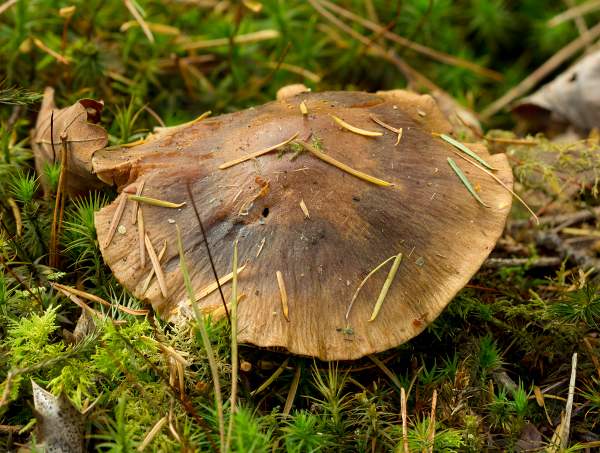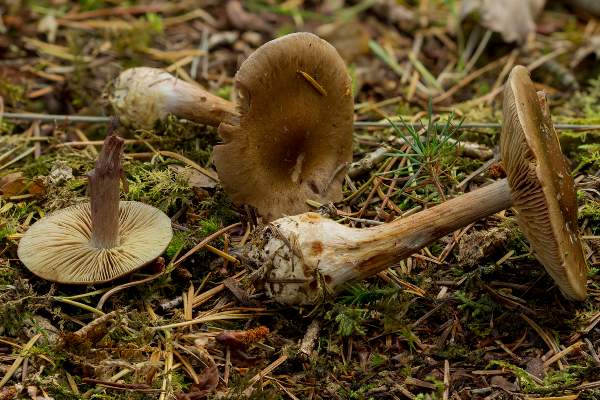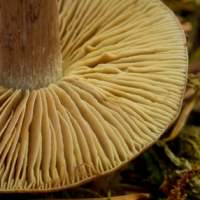Trees Birds Mammals Fish Amphibians Reptiles
Wild Algarve
Bookshop
Cortinarius scaurus ( Fr.) Fr. - Green Webcap
Phylum: Basidiomycota - Class: Agaricomycetes - Order: Agaricales - Family: Cortinariaceae
Distribution - Taxonomic History - Etymology - Toxicity - Identification - Reference Sources

Cortinarius scaurus is a webcap of conifer forests and plantations. Its common name comes from a green or olive tinge to the margin and gills of immature specimens. Identification of webcaps is generally very difficult because there are so many similar species, but this green coloration is a key feature of Cortinarius scaurus.

Distribution
An uncommond species in England, Wales and Ireland but rather more common in Scotland, Cortinarius scaurus occurs also throughout much of mainland Europe and parts of Asia. This webcap is listed in Mycoquebec.org, and I infer therefore that it has been found in Quebec, suggesting that it might occur also in other parts of North America.
Taxonomic history
This largish webcap was described in 1818 by Elias Magnus Fries, who gave it the binomial scientific name Agaricus scaurus. In 1838 Fries renamed this webcap as Cortinarius scaurus, which to the present time remains its generally-accepted scientific name.
Synonyms of Cortinarius scaurus include Agaricus scaurus Fr., Myxacium scaurum (Fr.) P. Kumm., Phlegmacium scaurum (Fr.) Wünsche, Gomphos scaurus (Fr.) Kuntze, Cortinarius herpeticus Fr., Cortinarius scaurus var. herpeticus (Fr.) Quel., Gomphos herpeticus (Fr.) Kuntze, and Phlegmacium herpeticum (Fr.) Ricken.
Etymology
The generic name Cortinarius is a reference to the partial veil or cortina (meaning a curtain) that covers the gills when caps are immature. In the genus Cortinarius most species produce partial veils in the form of a fine web of radial fibres connecting the stem to the rim of the cap rather than a solid membrane.
The specific epithet scaurus is drived from the Greek adjective skaurus, meaning 'lame', but its significance ismore evident from the related Latin adjective scaurus meaning 'with swollen ankles', or 'club-footed' - a reference to the swollen stem base of this mushroom.
Toxicity
This webcap is generally regarded as 'suspect' and may contain dangerous toxins; it should not be gathered for eating. Some Cortinarius species with which darkish specimens of the Birch Webcap could possibly be confused contain the toxin orellanine, which if eaten destroys human kidneys and liver.
Identification guide
 |
Cap
2.5 to 5cm in diameter; conical or hemispherical at first, becoming campanulate and then expanding until broadly umbonate; brown an olivaceous tinge; darker brown at the centre; tinged grey-green at the margin when young and developing droplet-like darker brown spots. Surface greasy or slimy when wet. Cap flesh is brownish-white
Sp 9-11 x 6-7 μm, ellipsoid, densely verrucose (fig. 687A). With conifers on silicious soil; summer to autumn |
 |
Cortina
White, web-like; collapsing onto the stem to create a white ring zone.
Gills
The adnate gills are moderately spaced, greenish yellow, soon becoming olive-brown and then rusty brown. |
 |
Stem
The dry fibrous stems are 0.5 to 1cm in diameter and 4 to 9cm tall; cylindrical or clavate, often with a marginate bulb; initially pale bluish to blue-green, turning yellowish grey. Cortina fibres that collapse onto the upper stem become rust-brown as they collect some of the mature spores that fall from the gills. Stem flesh initially greenish blue to olivaceous, becoming brownish at maturity. |
 |
Spores
Ellipsoidal to amygdaliform (almond shaped), densely warty, 9-11 x 6-7μm; inamyloid.
Spore print
Rusty brown. |
Odour/taste |
Odour faint, sweet; taste mild to bitter. |
Habitat & Ecological role |
Ectomycorrhizal, in coniferous woodlands. |
Season |
July to November in Britain and Ireland. |
Similar species |
Cortinarius cinnamomeus has a darker cap and cinnamon gills. |
Reference Sources
Fascinated by Fungi, 2nd Edition, Pat O'Reilly 2016, reprinted by Coch-y-bonddu Books in 2022.
Funga Nordica, Henning Knudsen and Jan Vesterholt, 2008.
Fungi of Switzerland Agarics, part 3: Cortinariaceae, Breitenbach, J., Kränzlin, F.
Dictionary of the Fungi; Paul M. Kirk, Paul F. Cannon, David W. Minter and J. A. Stalpers; CABI, 2008
British Mycological Society. English Names for Fungi
Taxonomic history and synonym information on these pages is drawn from many sources but in particular from the British Mycological Society's GB Checklist of Fungi.
Acknowledgements
This page includes pictures kindly contributed by David Kelly.
Top of page...
Fascinated by Fungi. Back by popular demand, Pat O'Reilly's best-selling 450-page hardback book is available now. The latest second edition was republished with a sparkling new cover design in September 2022 by Coch-y-Bonddu Books. Full details and copies are available from the publisher's online bookshop...